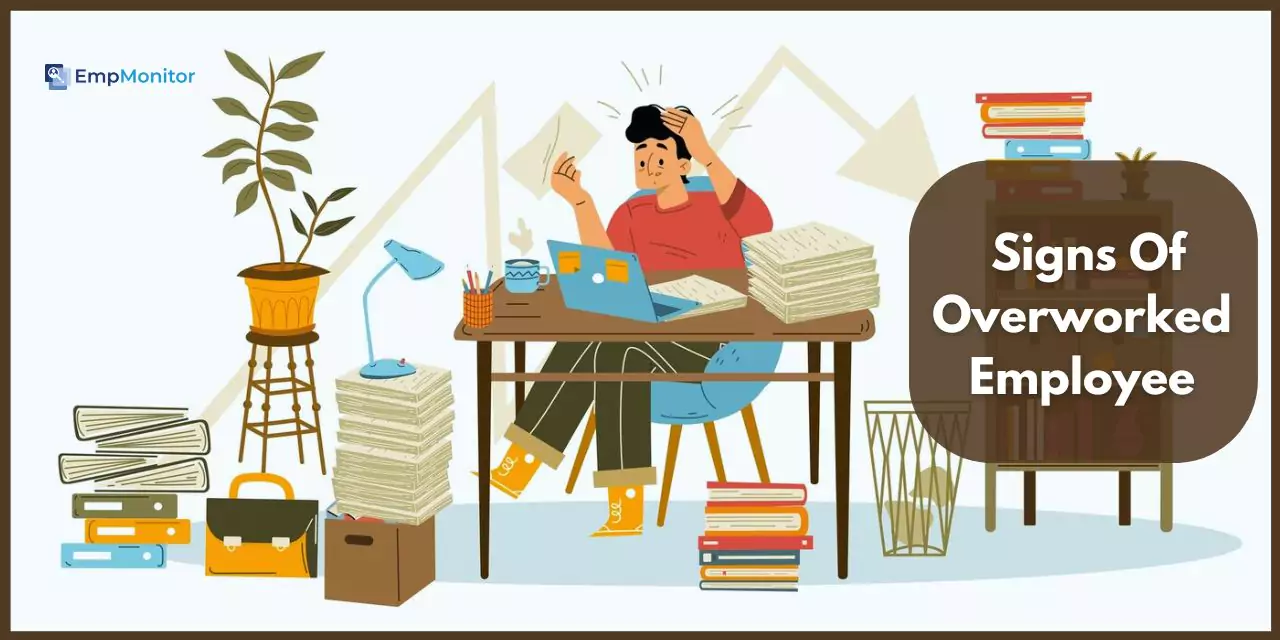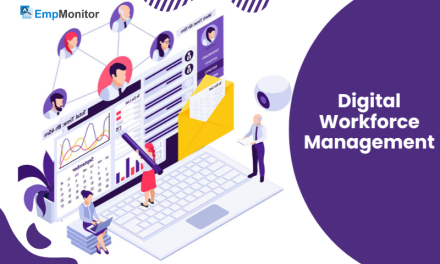In workplaces, stress and feeling unhappy can impact how businesses run, no matter how big or small they are. When employees start to feel burned out, it can mess up everything at work – from getting things done to keeping good workers around. But here’s the problem- many managers don’t realize when their employees are overwhelmed with too much work until it’s too late, and then those employees end up leaving to find a job with a better balance between work and life.
So, we’re here to help you spot the signs of overworked employees before it’s too late. In this blog, we’ll talk about- seven signs that show your team members might be taking on too much. Plus, we’ll give you some easy ways to make sure your workers are feeling good and doing their best work.
Stick with us as we delve into recognizing signs of being overworked and learn how to solve the issue of overworked employees to ensure your team feels good and performs at their best.
IN A HURRY? LISTEN TO THE BLOG INSTEAD!
What Is An Overworked Employee?
An overworked employee refers to someone who has reached the maximum level of productivity but lacks sufficient time to rest before resuming work. While this varies from person to person and job to job, every employee has a finite capacity for physical and emotional exertion. Overworking ultimately- leads to burnout and mental fatigue for the employee while also negatively impacting the organization’s outcomes.
Some Common Causes Of Overworked Employees:
During the 2008 economic downturn, many companies downsized their workforce and didn’t hire replacements, leaving existing employees to handle more tasks. Even as the economy recovered, employers continued to expect higher productivity from their staff. The year 2020 forced many industries to shift to remote work, blurring the lines between work and personal life for employees who found themselves- working longer hours without the usual office routines.
These factors have led to a widespread issue of overworked employees across various industries, with serious consequences for overworking employees and the organizations they work for.
In addition to economic influences, the internal workings of organizations also play a significant role in fostering employee overwork. Typical catalysts encompass factors- such as stringent deadlines, excessive workload expectations, and insufficient support systems. These elements can manifest as signs of an overworked employee. Common causes include:
- Insufficient Staffing: Teams with too few members struggle to meet goals, leading individuals to take on excessive workloads.
- Inadequate Planning And Project Management: Poorly managed projects often result in unrealistic deadlines and excessive- workloads for employees.
- Unreasonable Expectations: Competitive pressures may drive organizations to set unattainable targets, putting undue stress on employees to deliver.
- Lack Of Work-life Boundaries: Some managers inadvertently encroach- on employees’ time by expecting them to be available outside of regular working hours.
- External Stressors: Personal challenges like childcare responsibilities, family obligations, financial strain, and mental health issues add to employees’ workload stress, compounding the effects of heavy work demands.
What Are The Signs Of Overworked Employees?
Recognizing signs of overworked employees is essential for maintaining a healthy and productive workplace environment. Here are seven key indicators to watch for:
Decreased Productivity:
One of the most glaring signs of overworked employees is a noticeable decline in productivity. Overworking can lead to decreased efficiency, resulting in tasks taking longer to complete and an increase in errors. Research from the Harvard Business Review estimates that burnout-related lost productivity costs organizations between $125 billion to $190 billion annually.
Increased Absenteeism:
Overworked employees may struggle to show up for work regularly due to feeling physically and emotionally drained. Studies reveal that unscheduled absences can cost organizations up to 9.2% of their payroll annually, highlighting the significant impact absenteeism can have- on operations.
Reduced Engagement:
Employees, who are overworked at work experience burnout. Those employees tend to become disengaged from their work lacking motivation and enthusiasm. This disengagement contributes to a sense of purposelessness and can significantly affect overall organizational performance. Gallup polls indicate that only 34% of U.S. employees are engaged- at work, with burnout being a significant factor in this low engagement level.
Increased Irritability:
Overworked employees may display heightened irritability and short-tempered behavior toward colleagues, managers, or customers. It can lead to conflicts and a negative work environment, impacting teamwork and morale. Research by the American Psychological Association suggests that work-related stress is a significant source of frustration for many employees.
Lack Of Creativity:
Burnout can stifle an employee’s ability to think creatively and generate innovative ideas. Overworked individuals may feel mentally exhausted and unable to think outside the box, hindering progress and innovation within the organization. Accenture’s research highlights the importance of fostering a creative work environment for organizational success.
Physical Symptoms:
Signs of overworked employees can manifest in physical- symptoms such as headaches, back pain, and stomach issues. These symptoms are often a result of heightened stress and tension in the body due to excessive workloads. The American Institute of Stress estimates that job-related stress costs U.S. employers over $300 billion annually in healthcare and lost productivity.
Emotional Exhaustion:
Burnout often leads to emotional exhaustion, characterized by feelings of hopelessness, helplessness, and cynicism. Employees may struggle to cope with the demands of their jobs, experiencing symptoms of depression and anxiety. Research from the National Institute for Occupational Safety and Health highlights the prevalence of job-related stress and its impact on employee well-being.
By understanding and addressing these signs of overworking, organizations can take proactive measures to support their employees’ health and well-being, ultimately fostering a more resilient and productive workforce.
5 Tips To Avoid Overworking Employees
Here are five simple steps to help you avoid overworking your team and become a better manager:
Set realistic expectations: It’s important to understand that there’s only so much work that can be done- in a week. Pushing your team too hard can lead to them feeling stressed and overworked. By setting achievable goals and regularly discussing workload with your team, you can ensure everyone is on the same page and prevent burnout.
Effectively Prioritize Tasks: When everything feels urgent, it’s easy for employees to become overwhelmed. Help your team prioritize their tasks by identifying what’s most important and what can wait. It will allow them to focus their energy on what truly matters and avoid feeling stretched too thin.
Hire The Team You Need: If your team is consistently overloaded, it might be necessary to recruit additional members. Sufficient manpower ensures equitable distribution of tasks, preventing employees from feeling overwhelmed. If expanding the team isn’t feasible, concentrate on effectively prioritizing tasks and managing workloads. Signs of overworked employees should be acknowledged and addressed promptly to maintain productivity and well-being.
Check-in Regularly: As a manager, it’s important to keep an eye on how your team is doing. Regular check-ins provide an opportunity for employees to voice concerns and ask for help if needed. By staying connected and addressing any issues early on, you can prevent overwork and ensure your team feels supported.
Offer Tools For Better Time Management: Offering tools for better time management is crucial for improving productivity. Providing your team with resources like EmpMonitor can make a significant difference. EmpMonitor helps track employee activities, allowing for better understanding and allocation of time. Analyzing work patterns, aids in identifying areas for improvement and optimizing workflows.
It empowers employees to manage their time more effectively, resulting in increased productivity and reduced chances of burnout. Integrating employee monitoring software like EmpMonitor into your workflow can streamline operations and promote a healthier work-life balance for your team.
By integrating Empmonitor into your workflow and following these steps, you can cultivate a supportive work environment where employees thrive without feeling overworked.
EmpMonitor: Workforce Management Software
EmpMonitor stands out as a leading workforce management solution, offering comprehensive solutions to streamline and optimize various- aspects of managing a team. With its robust features and user-friendly interface, EmpMonitor empowers businesses to effectively- monitor, analyze, and enhance employee productivity and engagement.
EmpMonitor plays a crucial role in helping businesses identify and address signs of overworked employees by providing valuable insights into their work habits and behaviors. Here’s how EmpMonitor can assist in overcoming signs of overworked employees:
- Activity Monitoring: EmpMonitor allows managers to track employee activities in real time, including computer usage, application usage, and web browsing activities. By monitoring these activities, managers can identify employees who consistently work long hours or exhibit signs of burnout.
- Time Tracking: EmpMonitor offers comprehensive time tracking features, allowing managers to monitor how employees spend their time during work hours.
- Productivity Analysis: EmpMonitor provides insights into employee productivity levels, allowing managers to identify trends and patterns that may indicate overwork. By analyzing productivity data, managers can identify areas where additional support or resources may be needed- to alleviate workload pressures. Tracking productivity like this can make work better.
- Project Management: Efficient project planning is facilitated through streamlined processes, task assignments made effortlessly, and seamless real-time collaboration among team members. Comprehensive progress tracking and time reporting offer valuable insights into project efficiency and resource distribution, promoting a smoother journey toward achieving success.
EmpMonitor serves as a valuable tool for identifying and addressing signs of overworked employees by providing real-time insights. By leveraging these insights, managers can take proactive measures to support employees, prevent burnout, and promote a healthy work-life balance within the organization.
ALSO READ:
How To Identify & Effortlessly Solve Your Overworked Employees Workloads?
How Productivity Tracker Can Improve The Work Performance Of The Employees
Employee Burnout: 7 Tips To Deal With Effective Workforce Management Solutions
What To Do When Your Employees Feel Overworked?
When employees feel overworked tackling can seem like a daunting task, but it’s not insurmountable. There are practical steps managers can take to address and reverse the trend of overwork.
Step #1: Encourage Breaks and Vacations
It’s imperative to foster- an environment where employees feel empowered to take breaks and vacations without fearing repercussions. When a culture emphasizes constant work over well-being, employees might hesitate to utilize their breaks, particularly during busy periods. signs of overworked employees, such as decreased productivity or increased stress levels, should be closely- monitored to ensure their well-being.
As a leader, it’s vital to exemplify behavior that prioritizes work-life balance and vacation time. Even in organizations with “unlimited” vacation policies, employees may still be hesitant to take time off if they consistently see management working long hours.
To address this, consider offering paid vacation days as an incentive for employees to prioritize their well-being. Additionally, keep an eye out for signs of overworked employees, as this can indicate a need for intervention and support.
Step #2: Utilize Temporary Workers
If workloads become overwhelming, consider hiring temporary workers to alleviate the strain on your team. Engage in open communication with employees to identify areas where additional support is needed and where temporary workers could be beneficial.
Step #3: Respect Work-Life Balance
Encourage employees to maintain a healthy work-life balance by discouraging work-related activities outside of working hours. Emphasize the importance of disconnecting from work during personal time to allow for mental and emotional recharge.
Step #4: Implement flexible work hours
Introducing flexible work hours enables employees to efficiently manage their time, prioritizing tasks without the constraints of a fixed schedule. Research from the Harvard Business Review reveals that companies adopting flexible work arrangements witness increased employee satisfaction and engagement.
Surveys indicate that 80% of workers would decline job offers lacking such flexibility. When individuals feel empowered to control their schedules, they tend to adopt practices conducive to productivity, like taking breaks or working during peak focus times.
Step #5: Support Burnout Recovery
If employees are experiencing burnout, prioritize their mental health and well-being. Foster an environment where discussing mental health is normalized and destigmatized. Offer incentives for taking breaks and provide support rather than punishment for symptoms of burnout.
It’s crucial to recognize that burnout stems from excessive workloads and is not indicative of- laziness. By supporting employees through burnout, you can help them regain a healthy work experience and prevent further attrition.
By implementing these steps, managers can effectively address overwork issues and cultivate a healthier, more sustainable work environment for their teams.
Wrapping Up
Identifying signs of overworked employees is vital for maintaining a healthy work environment. By staying alert to indicators such as decreased productivity or changes in behavior, we can intervene early and offer the necessary support. It might involve adjusting workloads, providing additional resources, or leveraging tools like EmpMonitor for efficient time management.
Prioritizing employee well-being not only prevents burnout- but also cultivates loyalty and sustained performance. Let’s commit to creating- workplaces where employees feel valued and supported, ensuring they can thrive and contribute their best. In doing so, we not only enhance productivity but also promote a fulfilling and rewarding work experience for all. Moreover, staying attentive to signs of overworked employees allows us to address concerns promptly and ensure their well-being remains safeguarded.














